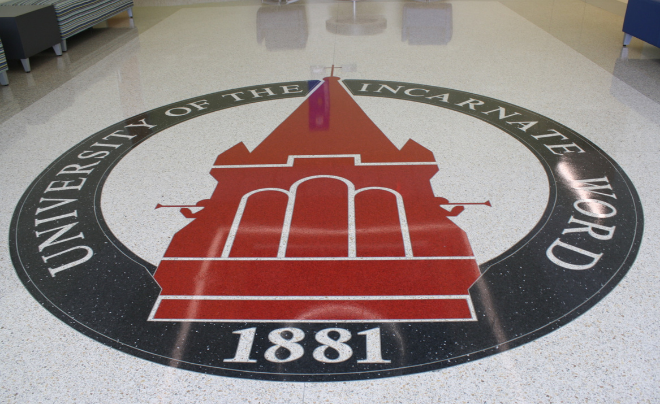TeleHealth takes Center-Stage at UIW as New Healthcare Norm
 San Antonio – As a second-year student at the University of the Incarnate Word’s School of Osteopathic Medicine, TJ Counce is learning all there is to know about the “hands-on” approach to treating patients. But suddenly Counce, along with everyone else, is getting a crash course in what it is like to treat a patient, and even be a patient, in the “hands-off” world of telehealth.
San Antonio – As a second-year student at the University of the Incarnate Word’s School of Osteopathic Medicine, TJ Counce is learning all there is to know about the “hands-on” approach to treating patients. But suddenly Counce, along with everyone else, is getting a crash course in what it is like to treat a patient, and even be a patient, in the “hands-off” world of telehealth.
“As a medical student, I understand how useful it is for the provider to be able to gather a history and perform a physical exam in person,” says Counce. “You can’t listen to the abdomen or percuss someone’s chest over Zoom. But we all have to adapt and do the best we can.”
And right now, the “best we can” may be turning out to be much better than expected. For the uninitiated, telehealth is exactly what it sounds like: a healthcare appointment delivered via a phone conversation or, more and more these days, a teleconference where doctor and patient can actually see each other. It is not a new concept, but in a time where social distancing due to the COVID-19 pandemic has made office visits infrequent at best, telehealth is more than a matter of convenience no matter it’s limitations.
“Medical providers are trained to use all of their senses to treat patients so the limited ability to touch, see, and hear has been a unique learning curve,” says Dr. Ronda Gottlieb, director of UIW Clinical Health Services. “We have had to become creative and teach our patients some assessment skills like how to palpate an abdomen, how to assess an ear for specific pain, and how to assess for edema. Telemedicine has been available for over 30 years so thankfully there are a lot of well written resources for it.”
Also over the course of the last 30 years, there has been a huge leap in teleconference technology. Today, many patients and doctors have easy access to the kind of high-tech that allows high-quality video-conferencing. Add to that the fact that doctors can more regularly check on a patient’s progress using telehealth and do so in a way that, more often than not, requires less time and money.
According to evisit.com, a recent study found the average doctor’s visit costs a patient $43 just in lost time – that’s in addition to the patient’s actual medical bill. “Telehealth services are more cost-efficient for both patients and healthcare professionals,” adds Gottlieb. “And, telehealth can allow professionals to engage patients to check on their adherence to their treatment plan, and likewise allows patients to dial in with questions about medications, appointments, and their conditions.”
Confidence in telehealth is tempered by the fact that there is simply no replacement for a face-to-face meeting with a health professional for possibly serious conditions. There can also be technical glitches with remote care and there is the fact that state regulations and guidelines have not completely kept up with the speed at which telehealth communication and necessity is moving.
“One of the biggest challenges for physicians and other healthcare professionals considering telemedicine is understanding and then coming to terms with regulatory and industry barriers to its use,” says Gottlieb. “Because of the COVID-19 pandemic, Texas telemedicine laws and regulations have been greatly expanded. The Texas Medical Board has declared that telemedicine – including the use of telephone only – may be used to establish a physician-patient relationship during the statewide disaster declaration issued in March, but the standard of care must be met in all instances. In addition, several changes to telemedicine visits have taken effect in response to COVID-19, including payment for services and which platforms can be used.”
Still, there is no doubt that the current state of how health care is being accessed has changed and most believe that change is here to stay in some shape or form.
“Absolutely!” says Gottlieb. “UIW Health Services has learned so much about telemedicine that we hope to add it as a continued service. Many of the health professions students do rotations out of town and telemedicine would greatly improve their access to services. Like any other change, there was some fear of the unknown. We have four physicians and five nurse practitioners in our clinic and over the past month we have all become very comfortable practicing in this environment.”
As for a medical student like Counce, tele-health is evolving into just one more lesson to be learned as a doctor in training. A sign of the times that is likely to be the new normal in the years to come and a chance to turn bedside manner, into webside manner.
“I think the biggest take away is listen to your provider,” says Counce. “Don’t be afraid to use telehealth because it is still an interaction with a healthcare professional. There is a lot of data showing that folks are utilizing healthcare less during this time, which is good in the sense they do not need to unnecessarily expose themselves to COVID-19, but it is bad because serious or otherwise preventable illnesses are not being caught and treated. I think telehealth is an excellent, safe and useful bridge between these two extremes and offers people a viable option in these uncertain and extraordinary times.”

